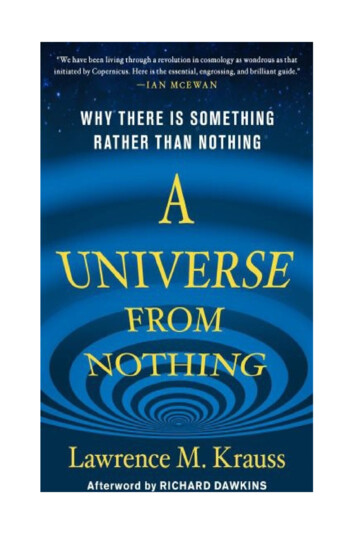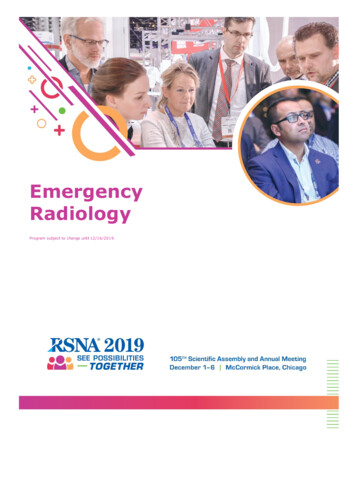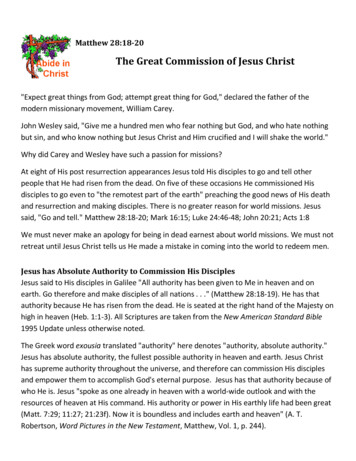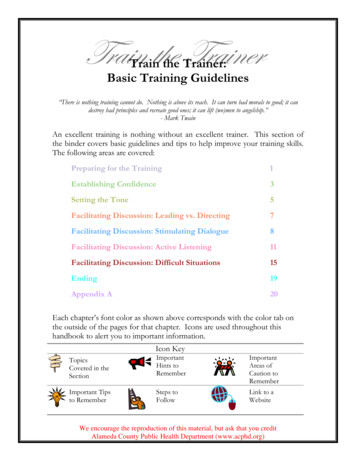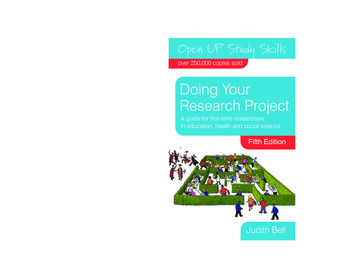
Transcription
How To Cure:OverweightObesityType 2 DiabetesMetabolic SyndromeInsulin ResistanceFatty LiverHigh Blood PressureHigh CholesterolHigh Triglycerides.and many more.By DoingABSOLUTELYNOTHING!!A guide by T. Naiman MD1 of 11
Time-Restricted EatingFed vs. FastedYour body is designed to smoothly transition betweentwo different and opposing states: ‘Fed’, and ‘Fasted’.In the fed state, insulin is elevated, and this signals yourbody to store excess calories in your fat cells. In thepresence of insulin, the burning of fat is halted, whilethe body burns glucose (from your last meal) instead.In the fasted state, insulin is low (while glucagon andgrowth hormone, opposing hormones to insulin, areelevated). The body starts mobilizing stored body fatfrom your fat cells and burning this fat for energy(instead of glucose).The practical importance of all this? You can only burnstored body fat while in the fasted state, and you canonly store more body fat while in the fed state.Insulin ResistanceUnfortunately, over time we seem to be spending less and less of our time in the fasted state and more andmore time in the fed state. As a result, our bodies and our cells spend less and less time mobilizing andburning stored body fat for energy, and the glucose-burning pathways are overused.Eventually, insulin is high all the time and the body avoids burning stored body fat, relying mostly on glucose.Over time, this chronic exposure to so much insulin also leads to ‘insulin resistance’ where the body secreteseven more insulin in response to the fed state. Chronic insulin resistance is the cause of ‘MetabolicSyndrome’: obesity, abdominal fat storage, high triglycerides, low HDL or “good” cholesterol, and elevatedglucose with eventual type 2 diabetes (1 in 12 humans on earth currently have full blown type 2 diabetes,while 35% of adults and 50% of older adults have Metabolic Syndrome, or pre-diabetes).Someone with insulin resistance is burning predominately glucose on the cellular level, and they rarely everget the opportunity to burn any body fat. When these people run out of glucose from their last meal, insteadof easily transitioning over to the fasted state to burn fat, they become hungry for more glucose (fromcarbohydrates) as their bodies and cells have decreased capacity for mobilizing and burning fat for energy.Let’s put it this way. Why would a highly obese person EVER be hungry? They have enough fat stores to lasta very long time. The world record for fasting went to a 456 pound man who fasted for 382 days, consumingonly water and vitamins and losing 276 pounds with no ill effects. But the average overweight person is usedto being in the fed state, has very little practice in the fasted state, and is continually burning glucose ratherthan fat at the cellular level. They have insulin resistance, which is both caused by and also leads tochronically high insulin levels, which promotes fat storage and suppresses fat mobilization from theadipocytes (fat cells). They even have changes in the mitochondria, or tiny energy factories inside the cells.The mitochondria can burn either glucose (sugar) or fat for fuel, and over time they will have a preference forone over the other; “sugar burners” have increased the pathways in the mitochondria that burn glucose anddecreased, or down-regulated, the underused pathway for burning fat. So what happens to the overweight“sugar burner” who stops eating for a few hours? As they run out of glucose from their last meal, instead ofseamlessly transitioning to the fasted state and mobilizing and burning stored body fat, they become2 of 11
HUNGRY for MORE GLUCOSE, from carbohydrates! They will spend most of the day trapped in a cycle ofeating every few hours, spiking glucose, and then becoming hungry when blood sugar drops.A good analogy is that of a tanker truck on the freeway filled with oil. If the tanker truck runs out of gas itstops moving, despite the fact that it has 10,000 gallons of potential fuel on board. Why? Because it prefersto run on refined gas and is incapable of burning oil for fuel.Fat AdaptationHumans have the ability to become ‘fatadapted’ and improve their ability to fuelthemselves with stored body fat insteadof glucose. However, this takes timeand practice, and your body has to do anumber of things to slowly up-regulate(or increase) your fat-burning pathways.This includes improving insulin sensitivityto lower insulin and promote fatmobilization into free fatty acids from theadipocytes (fat cells) as well as upregulating the fat-burning pathways atthe cellular level (in the mitochondria).There are several ways to improve ‘fatadaptation’ or the ability to successfullyburn stored body fat for energy, andthese include the following: Low carbohydrate diets. Eating a LCHF (Low Carb High Fat) diet improves the body’s ability to utilize fat for energy rather than glucose, as there is more fat and less glucose available at all times, even in thefed state.Exercise. High-intensity exercise depletes glucose and glycogen rapidly, forcing the body to switch overand utilize more fat for fuel. Exercise also improves insulin sensitivity.Caloric restriction. Eating fewer calories also equals less glucose available for fuel, so the body is morefrequently forced to rely on stored body fat for fuel. You will always naturally eat the lowest calorieswhen you are maximizing nutrient density by eating whole, natural, unprocessed, real foods found innature (avoid processed foods completely).Intermittent fasting, and spending more time in the fasted state, which gives the body more ‘practice’ atburning fat.Metabolic ExerciseThe purpose of this is to highlight INTERMITTENT FASTING as a strategy for exercising and strengtheningthe body’s ability to exist in the fasted state, burning fat instead of continually burning sugar (glucose) fromthe fed state.Just like anything else, this ability can be strengthened over time with practice. But this ability also atrophiesor shrinks over time with lack of use, just like your muscles atrophy when you break your arm and have towear a cast for weeks.Spending time in the fasted state is actually a form of exercise—a METABOLIC WORKOUT.3 of 11
In fact, there are a lot of parallels between exercise and fasting.Exercise does all of the following great things: Decreases blood glucose.Decreases insulin level.Increases insulin sensitivity.Increases lipolysis and free fatty acidmobilization.Increases cellular fat oxidation.Increases glucagon (the opposite of insulin).Increases growth hormone (the opposite ofinsulin).BUT did you know you can also accomplish all ofthe above by doing ABSOLUTELY NOTHING?The secret is *FASTING*. Extending the amount oftime that you spend during your day in theFASTED state (as opposed to the FED state)accomplishes all of these, very similar to exercise.Extending your time in the fasted state is actuallya form of metabolic 'exercise', in which you trainyour body to rapidly and efficiently mobilize freefatty acids from your adipose stores (fat tissue),something you absolutely can get better andbetter at with the metabolic 'practice' of fasting.Just as overweight and out of shape peoplestruggle to jog or lift weights or participate in otherforms of physical exercise, they are also generallyout of practice when it comes to rapidly andefficiently mobilizing and burning stored free fattyacids for fuel. Intermittent fasting and spendingmore of your day in the 'fasted' state (and lesstime in the 'fed' state) is a great form of metabolic'exercise' which has many health benefits, includingfat loss!Less Feeding, More FastingOne of the best ways to achieve effortless and long-lasting fat loss? Train yourself to eat two meals a day(and eliminate snacking). The easiest and best way to accomplish this? Leverage your natural overnight fastby skipping breakfast (drinking coffee makes this easier and more enjoyable, plus coffee has numeroushealth benefits). No breakfast, lighter lunch, and larger dinner also maximizes the body's natural shiftsbetween sympathetic (“fight or flight”) and parasympathetic (“rest and digest”) nervous system tone, withhigher alertness and activation from sympathetic tone during the day while under-eating, and higherparasympathetic resting tone in the evening during the fed state.Typically, the fed state starts when you begin eating and for the next three to five hours your body digestsand absorbs the food you just ate. Insulin rises significantly, completely shutting off fat-burning and alsotriggering excess calories to be stored as fat. After the first few hours mentioned above, your body goes into4 of 11
what is known as the post–absorptive state, during which the components of the last meal are still in thecirculation. The post–absorptive state lasts until 8 to 12 hours after your last meal, which is when you enterthe fasted state. It typically takes 12 hours after your last meal to fully enter the fasted state.When you’re in the fastedstate your body can burnfat that has beeninaccessible during thefed state. Because wedon’t enter the fastedstate until 12 hours afterour last meal, it’s rare thatour bodies are in this fatburning state. This is oneof the reasons why manypeople who startintermittent fasting willlose fat without changingwhat they eat, how muchthey eat, or how oftenthey exercise. Fastingputs your body in a fatburning state that yourarely get to enter duringa normal eating schedule.Avoid CarbohydratesEating carbohydrates, especially refined carbohydrates with no fiber, overdrives the 'fed' state, ascarbohydrates raise both glucose and insulin higher than other macronutrients (fat, on the other hand, raisesglucose and insulin the very least). In general, when you eat a meal, your body spends a few hoursprocessing that food and burning what it can from what you just consumed. Because it has all of this readilyavailable, easy to burn energy in its blood stream (thanks to the food you ate), your body will choose to usethat as energy rather than the fat you have stored. This is ESPECIALLY true if you just consumedcarbohydrates, because these are rapidly converted to glucose and your body prefers to burn sugar asenergy before any other source (high glucose is toxic and your body burns extra glucose preferentially to getrid of it, much in the same way that the body burns alcohol consumed for energy prior to other energycalories--alcohol therefore also sabotages fat loss).Exercise HelpsExercise helps greatly with fat adaptation. Your glycogen (the storage form of glucose in your muscles andliver that your body can burn as fuel when necessary) is depleted during sleep and fasting, and will bedepleted even further during training, which can further increase insulin sensitivity. This means that a mealimmediately following your workout will be stored most efficiently: mostly as glycogen for muscle stores,burned as energy immediately to help with the recovery process, with minimal amounts stored as fat.Compare this to a regular day (no intermittent fasting). With insulin sensitivity at normal levels, the carbs andfoods consumed will see full glycogen stores, enough glucose in the blood stream, and thus be more likely toget stored as fat.Fasting MythsThere are many myths about fasting:5 of 11
“Breakfast is the most important meal of the day!”We have all been told to eat breakfast. Unfortunately this is terrible advice. When you first wake up in themorning, your insulin level is quite low and most people are just starting to enter the fasted state, 12 hoursafter eating the last meal of the previous day. The worst thing you could do is to eat food, spiking insulin andglucose and immediately shutting off fat-burning. A much better choice would be to push the first meal ofyour day out at least a few hours, during which you can fully enter the fasted state and burn stored body fat.The VERY WORST would be to eat a high carbohydrate breakfast, spiking insulin and glucose as high aspossible; in addition to shutting off fat-burning for likely 12 hours, this will drive as many calories as possibleinto fat stores as well as providing further reinforcement of the burning of glucose rather than fat. Also, highspikes of insulin and glucose always lead to large drops in glucose a few hours later, which triggers HUNGER(if you want to have hypoglycemia or low blood sugar and ravenous hunger, just eat a breakfast of purecarbohydrates and then wait 2-3 hours to see how you feel). Interestingly, many properly fat-adapted peoplearen’t very hungry in the morning and have no problem skipping breakfast. This is appropriate, as throughoutour evolution humans have always been hunter-gatherers and rather than eating a large breakfast first thingin the morning we would hunt and gather throughout the day, having a larger meal later in the day. I highlyrecommend mimicking this pattern by skipping breakfast and eating most of your calories later in the day(referred to as a ‘reverse taper’ of calories, with none in the morning and most in the evening).“Eat small frequent meals.”There has been plenty of worthless advice here. We have been told to eat frequently to “keep yourmetabolism going” and “don’t let your body enter starvation mode”. This is all the exact opposite of the truth:in order to burn fat, you want to spend as much time in the fasted state as possible and get very veryefficient at living on stored body fat rather than caloric intake from constantly eating. Similarly we have beentold to eat protein frequently throughout the day in order to build muscle, and this is also not evidencebased. Yes you do want to eat an adequate amount of protein to build muscle, but eating it once a day isplenty.“Fasting leads to burning muscle instead of fat.”Many people are concerned that if they start fasting they will either stop making muscle or maybe even burnmuscle. This is not true. If this were true, humans would not be here today. In fact, growth hormone isincreased during fasted states (both during sleep and after a period of fasting). Growth hormone might aswell be called “fasting hormone”, as it rises by as much as 2,000% after 24 hours of fasting. Growthhormone is highly anabolic (builds muscle), and is used in combination with testosterone by bodybuilderswho want to simultaneously build as much muscle and burn as much fat as possible. Growth hormoneelevates in fasting to help preserve muscle in times of fasting, and this makes sense. In our hunter-gathererancestors, if fasting and going without food made you weaker and slower you would never catch or find anyfood and you would die and humans would become extinct. In fact the opposite is true; while fasting, muscleis preserved or can even grow if you are doing resistance training (highly recommended). Also, peopleexperience a increased level of focus and alertness during fasting thanks to the release of epinephrine andnorepinephrine (earlier in our evolution this increased energy and alertness helped us catch prey whennecessary).“Your metabolism slows down when you are fasting.”This is completely false. A number of studies have proven that in fasting up to 72 hours, metabolism doesnot slow down at all and in fact might speed up slightly thanks to the release of catecholamines (epinephrineor adrenaline, norepinephrine, and dopamine) and activation of the sympathetic nervous system (sympatheticnervous system is often considered the “fight or flight” system, while the opposite is the parasympatheticnervous system or the “rest and digest” system). It makes sense that this fight or flight sympathetic nervous6 of 11
system would be activated during the daytime, when hunter-gatherer humans are most active and in thefasted state (looking for food), followed by parasympathetic “rest and digest” mode in the evening aftereating a large meal.“If I don’t eat I will get low blood sugar [hypoglycemia].”Studies have shown that healthy persons who have no underlying medical conditions, who are not takingany diabetes medications, can fast for extremely long periods of time without suffering from anyhypoglycemia. In fact, almost all sensations of hypoglycemia or low blood sugar (in non-diabetics) resultsfrom eating a very high glycemic index carbohydrate food a few hours prior (blood sugar spikes, then insulinspikes, then blood sugar drops rapidly). However if you are a diabetic, especially if you are on any diabetesmedications, you definitely need to check with your doctor before starting a fasting protocol. Some diabetesmedications can lead to severe hypoglycemia when fasting (mostly insulin and sulfonylurea drugs likeglipizide, glimepiride, and glyburide). [Be sure to check with your doctor prior to starting a fasting protocol ifyou have any medical problems, diabetes or otherwise.]How To Fast IntermittentlyThere are a number of ways to actually perform intermittent fasting, but the easiest and most popularvarieties involve taking advantage of your natural overnight fast by skipping breakfast and pushing the firstmeal of the day forward a number of hours. Once you have passed the 12 hour mark from dinner the nightbefore, you are truly in a fasted state and you begin to rely on stored body fat for fuel. The longer you stay inthe fasted state, the more metabolic practice you will get at burning stored body fat and the deeper your fatadaptation will get. In fact, if you can maintain this intermittent fast for 20 to 24 hours you will achieve a veryhigh rate of lipolysis (breakdown of stored body fat into free fatty acids, available for burning in the cells) andfat oxidation (burning of fat in the mitochondria).When you first start out with intermittent fasting, you can have quite a bit of hunger and low energy and othersymptoms. In this case I recommend starting out with “baby steps”, by just pushing breakfast out an hour ortwo at first, then slowly increasing the fasting interval. As time goes by and you become more “fat adapted”,it is easier and easier to fast. This is identical to exercise in those who are sedentary: it is painful andextremely difficult at first, and then once you are adapted it gets easy and even enjoyable.LCHF Diet For Fat AdaptationIt is much easier to fast if you are already on a LCHF (low carb high fat) diet, as these diets naturally lead toquite a bit of fat adaptation and are naturally lower in the secretion of insulin as well as the utilization ofglucose as a fuel. In fact, I HIGHLY recommend the combination of a very low carb diet with intermittentfasting. The closer you get to a ketogenic diet (extremely low in carbohydrates, moderate in protein, and highin fat) the easier it is to go for hours and hours without eating, thanks to the fat adaptation that these dietslead to.For those who do incorporate carbohydrates in the diet, I would recommend that these mostly consist ofFIBER, which is indigestible and does not contribute to the elevation of glucose and insulin. If you do decideto eat digestible carbohydrates, I would DEFINITELY NEVER eat these early in the day, as this will contributehugely to fat storage and sabotage fat burning a lot, as well as setting you up for a blood sugar and hungerroller coaster for the rest of the day. I would ONLY eat digestible (non-fiber) carbohydrates in the evening, andideally only after either fasting for a long period (to deplete liver glycogen) or exercising with a high level ofintensity to deplete muscle glycogen (eating digestible carbohydrates when your muscle and liver glycogenare already full is guaranteed to lead to fat storage and worsening insulin sensitivity, the exact opposite ofwhat you are looking for).Popular Forms Of Intermittent Fasting7 of 11
There are several popular ways to accomplish intermittentfasting and I will discuss the three most popular varietiesnext. All of these involve lengthening the overnight fast byskipping breakfast and postponing the first meal of theday. All of these also involve eating no calories at thebeginning of the day and the majority of your calories verylate in the day, a concept called a caloric ‘reverse taper’.Keep in mind that for the purpose of thesediscussions we will consider the baselinestandard diet to involve 12 hours of fasting(overnight) plus 12 hours of an eatingwindow during the day consisting of threemeals, breakfast, lunch, and dinner.The sad reality however is that most people are actually eating first thing in the morning until late at night,with lots of snacking, so the eating window for the average American is probably even larger than 12 hours.LeangainsLeangains, as popularized by bodybuilder Martin Berkhan, is by far the most popular method of fastingintermittently. This form of fasting consists of skipping breakfast every morning and pushing the first meal ofthe day to lunch. Basically you skip breakfast and then eat a normal lunch and dinner in an eight hourwindow. The idea is to fast for 16 hours (overnight plus the first 6 hours of your day), then eat all yourcalories in an 8 hour window. For example, let’s say you get up at 6:00 a.m. You would skip breakfast andeat nothing for six hours, then lunch at noon and dinner at 8:00 p.m. Snacking inside your eating window isallowed (although I will say that generally speaking you want to try to consolidate calories into larger mealsrather than snacking). This 16:8 split (16 hours fasting and 8 hours eating) is recommended every single day.If you had one day off from this protocol and followed this the other six days of the week, that would amountto an additional 4 hours of fasting per day compared to the standard 12:12 split that we are assuming to bebaseline (12 hours fasting and 12 hours eating). Four hours per day times six days per week equals about 24hours of total additional fasting per week. [4 hours fasting per day times 6 days per week 24 hours]Warrior DietThe Warrior Diet, as popularized by Ori Hofmekler, consists of fasting during the majority of the day, theneating all of your calories in the evening. The goal is to skip breakfast and lunch, then eat a huge dinner in afour hour window at the end of the day. This is a 20:4 hour split (20 hours of fasting and then a 4 hour eatingwindow at the end of the day). This method of fasting does allow you to eat very large very satisfying mealsat the end of the day, and might be perfect for someone who was going out to dinner to eat in a social8 of 11
setting, where a ton of calories and food might be involved. Fasting this long during the day is more difficultbut does lead to a deeper level of fat adaptation and low insulin (which helps improve insulin sensitivity). Ifone followed this protocol roughly every other day (let’s say three days a week), that would equate to eighthours of fasting compared to the 12:12 baseline standard diet, times three days per week would also equalabout 24 hours of total additional fasting per week. [8 hours fasting per day times 3 days per week 24hours]Eat Stop EatEat Stop Eat, as popularized by bodybuilder Brad Pilon, involves fasting for an entire 24 hours, two days perweek. Let’s say you eat your last meal of the day at 8:00 p.m. the day before. You fast overnight and then allthe following day, skipping breakfast and lunch, and then pushing dinner out to 8:00 p.m. (for a full 24 hourswith no calories). This is quite difficult and is only recommended two days per week (nonconsecutive). Whilethis is quite difficult, by the end of the 24 hours you do reach a very deep level of lipolysis and fat oxidation,with very low insulin levels, and this is quite desirable. Many people think that the following day they will bingeon so much food that the benefits of the fasting on the previous day will be negated, but this is not true.Studies have repeatedly shown that persons will overeat by hundreds of calories the next day, but still notcome anywhere close to eating as much as they would have by eating normally both days (in other words,you are still left with a large net caloric deficit even after eating more food the day after your fast). Each daythat you fast in this fashion adds 12 hours of fasting compared to the standard 12:12 split we are calling9 of 11
baseline, and two days per week of this again equals about 24 hours of total additional fasting per week. [12hours fasting per day times 2 days per week 24 hours]It’s All GoodWith all of these fasting methods, the goal is to skip breakfast, avoid snacking, and consolidate calories nearthe end of the day. All of these methods are quite effective, and you can in fact mix and match these asmuch as you would like. I would highly recommend keeping it flexible. Fast for as long as is convenient onany given day, and break your fast whenever you need to or want to. Anything beyond a 12 hour window isgoing to be at least somewhat beneficial towards anyone’s goals. If you planned on fasting 16 hours but onlymake it 13, that’s ok and you are still much better off than if you had eaten all day long with early and latecalories plus lots of snacking.I think a good goal would be 24 hours per week of additional fasting (additional to the standard 12:12baseline). This could be 2 days of 24 hour fasting (Eat Stop Eat), 3 days of 8 hour fasting (Warrior Diet), or 6days of 4 hour fasting (Leangains). You could also mix and match as desired. Keep it flexible and go withwhatever best suits your schedule and your lifestyle and your current level of fat adaptation.Coffee AwesomeDuring the fasts feel free to drink ANY noncaloric beverage you want, including but not limited to: water,coffee (with or without noncaloric sweetener such as stevia), tea (hot or iced, sweetened with stevia ifdesired), diet soda with no calories (I recommend Zevia brand sweetened with stevia), or any other beveragewith no calories. However I would NOT recommend any calories AT ALL, as it takes frightfully few calories tospike insulin and sabotage your fast. Fat is the macronutrient that spikes insulin the very least, which is whyso many people are using Bulletproof coffee or some other method of adding fat (butter, coconut oil, etc) to10 of 11
coffee in the morning. However, I would NOT recommend this or any other source of calories while fasting,as this will be detrimental to what you are trying to accomplish with fasting. If you will absolutely die withoutat least a tiny splash of cream in your coffee well then do it, you will be better off with it than if this prohibitionagainst cream in your coffee keeps you from trying to fast intermittently at all (95% fasting much better than0% fasting)! However I would try to keep the cream in your coffee to an absolute MINIMUM quantity, and youshould also use this opportunity to learn to drink coffee black (this is something anyone can learn over time,believe it or not). I *HIGHLY* recommend the use of black coffee or tea in the morning to make your fasteasier and more enjoyable. Both coffee and tea have numerous health benefits, and they both containcompounds that help with fat burning, energy, and alertness.Enjoy Your Newfound Freedom From FoodOnce you are properly fat adapted, intermittent fasting is actually easy, fun, enjoyable, and liberating—whilemaking you leaner and healthier in the process! Let’s say you are following the Leangains protocol. Breakfastevery day during the work week is now JUST BLACK COFFEE, how easy is that? No more worrying aboutwhat you are going to grab for breakfast as you rush around in the morning and struggle to get to work ontime. This saves you a ton of time and work and effort and is literally a form of metabolic exercise in themeantime, improving your insulin sensitivity and strengthening your fat adaptation. This is a win in manyways. It also frees you to eat very large and satisfying meals in the evening, without feeling the deprivation ofwatching calories or restricting yourself. And on days where you skip breakfast and lunch, you will beamazed at how much extra time you will have when you don’t have to worry about what to eat, where to getit, and when to find time to eat it. Your productivity will be higher as concentration and focus is higher in thefasted state (thanks to the sympathetic nervous system activation and catecholamines), and you will havemore free time.Some Pointers Check with your doctor before initiating intermittent fasting, ESPECIALLY if you are diabetic and ondiabetes medications! You can generally take any vitamins or supplements you want while fasting as long as they don’t have calories, but you don’t need any supplements as you will be eating plenty of nutrient-dense foods everyday.You don’t have to worry about losing muscle from lack of protein during your fast, as long as you eatadequate protein at the meals before and after fasting.You will not lose muscle while fasting as long as you are exercising regularly, and I specifically recommendresistance training such as lifting weights.Following a LCHF (low carb high fat) diet pairs nicely with intermittent fasting, as both improve fatadaptation a great deal.It is perfectly fine to exercise while fasting, either cardio or lifting weights (lifting weights is better for bodycomposition and I highly recommend it for everyone, as this will further your goals considerably).Drink plenty of water and non-caloric beverages while fasting; coffee and tea in the morning make fastingconsiderably more enjoyable in addition to health and fat-burning benefits and are therefore highlyrecommended.Don’t use intermittent fasting as an excuse to eat tons of junk food when you are eating—continue to eatresponsibly, sticking with whole natural foods with high nutrient density and avoiding processed foods!11 of 11
burn stored body fat for energy, and these include the following: Low carbohydrate diets. Eating a LCHF (Low Carb High Fat) diet improves the body’s ability to utilize fat for energy rather than glucose, as there is more fat and less glucose available at all times, even in the fe

